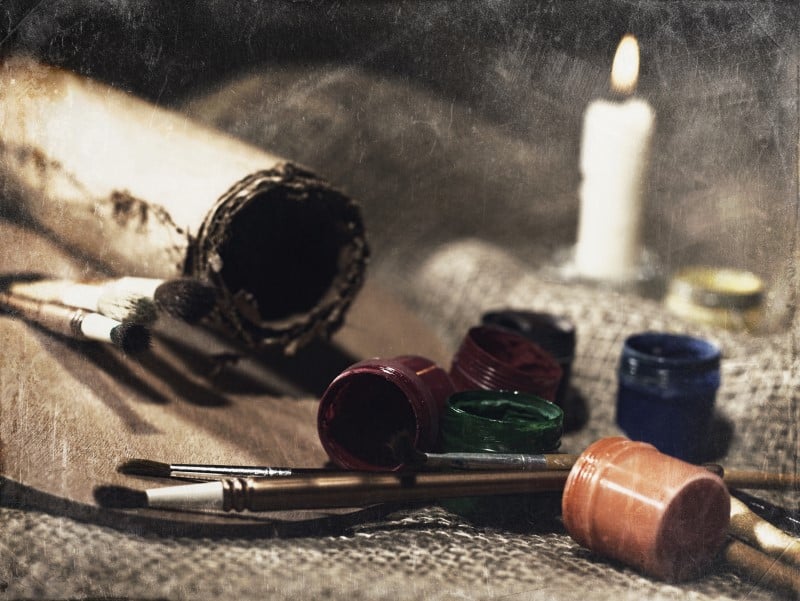I’m sure you’ve seen cute candle jars out there in the world. When you’re looking to buy a candle to personalize your decor, sometimes the jars are the right color, but you might dislike the pattern or vice versa. While candle jars can be decorative, sometimes you’d prefer to see a design on the actual candle. This dilemma might cause you to wonder, can you paint candles?
Not every type of paint sticks to a candle’s slick surface, but with the right tools and a plan, you can actually paint on candles. There are many different ways to decorate candles according to your preference. With patience and consideration, you can complete this project in little time.
Continue reading to learn more about the supplies you need and steps you can take to safely paint your candles.

Candle Painting Supplies & Overview
First, I will assume that you are preparing scent-free candles for decoration. Unscented candles are the best option for this project because the essential oils found in scented candles might cause the paint to peel off or not stick at all in the first place.
If you don’t already have unscented candles on hand, you may want to consider these six-inch cream-colored pillar candles; they’re also available in white and in multiple height variations. Tapered candles are another option and all three sets mentioned here are made with 100% cotton wicks.
I would suggest ordering more than you think you will need because you might have to experiment with painting one or two candles in order to practice the process before settling on your final design.
Beyond choosing which candles you are going to use, you will need the following tools as well:
- Rubbing alcohol
- Lint-free cloth
- Water-based acrylic paint
- Candle painting medium
- Paint palette (disposable plate or container)
- Plastic spoon or craft stick
- Paint brush or craft sponge
- Flexible stencils or painter’s tape (optional)
- Rhinestones (optional)
- Acrylic sealant (optional)
In terms of paint, be certain to buy a good grade of non-toxic, water-based paint. Use the paintbrush that’s most comfortable for you. I primarily like round paint brushes but flat brushes would also work well for a project like this, too. With a combination of brushes you can create various designs and effects.
Also, painter’s tape is available in many different widths. Choosing multiple ones can also increase your decorating options.
Step One: Preparing The Candle Surface
The first thing you want to do is apply some alcohol to your lint-free cloth. Next, wipe down the sides of your candle. This will remove any excess oils and lint that might prevent paint from adhering to the surface.
At this point I would suggest determining the kinds of patterns or designs you want to paint onto your candles. This is where you would choose between flexible stencils that allow you to easily paint in designs, or painter’s tape to block off areas where you don’t want to add paint.
For instance, you can wrap bands of tape in rows around the candle to paint in a horizontal striped pattern. You can also overlap tape across and down the candle between drying stages for a checkered effect.
Freehand painting is also an option, of course. You can use the tip of a round brush to create a polka dot pattern, paint in simple floral patterns, or even use a small brush to write in brush calligraphy.
When deciding on a final design, consider how you want to use and display the candles and which colors would work best for the project you have in mind.
Step Two: Prepping Your Paint
Now that you’re ready to paint your candles, the first step is to pour some acrylic paint onto your palette. Your palette can be a disposable plate, an old plastic container, foam tray, or any other flat surface that you don’t mind throwing away. Acrylic paint hardens when it dries, so whatever you use will likely need to be discarded once you’re done painting.
A flat glass surface is also an option but you will have to scrape the paint off with a putty knife or something similar after the paint dries. You may or may not be able to restore the glass to its original state. I’ve found that rubbing alcohol can help with that, though.
Now onto painting. At this point you want to add an equal amount of candle painting medium to the acrylic paint on your palette and stir them together with a plastic spoon, craft stick or something similar. Most craft stores carry candle painting medium, or you can buy it online. This painting medium will help the paint adhere to the candle’s waxy surface.
Step Three: Decorating the Candle
Once they’re mixed well, use your paintbrush to apply paint to the sides of your candle freehand, with stencils, or in areas around painter’s tape. Work slowly and apply even brushstrokes.
If you’re using stencils, you can wrap a stencil around the candle and then use tape to hold it in place as you paint. If you don’t have tape, just use your free hand to old it in place as you paint. Try to keep it still for a clean design transfer. It might be better to apply paint with a sponge or stippling brush if you are using stencils.
Regardless of the painting method you choose, you want to be sure to paint on the outer wall of the candle. Steer away from the candle wick! By painting the sides only, it’s less likely that painted areas will come in contact with the open flame once the candle is lit.
Once you’ve painted your first coat, you want to let it dry completely before adding another layer of paint. I find that placing the wet candle in a candle holder works well for me.
Multiple layers of paint are optional and based solely on your preference. If you plan to apply only one coat of paint, still wait for it to dry before removing stencils or painter’s tape. Plan to hold your stencils in place by hand? Wait at least a few seconds for the paint to adhere some before pulling the stencil up.
Step Four: Post-Decoration
After a few hours the paint is usually completely dry. You can test this by lightly touching it. Completely dry paint will feel smooth but if it’s not quite dry, it’ll feel sticky. If it’s tacky, then wait a little longer – about 30 minutes to an hour.
Once dry, slowly remove any tape you might have used. Pull back slowly in the opposite direction, not on an angle. The same is true for the tape used to hold down stencils. You would also want to slowly remove the stencil by lifting up in the opposite direction.
When adding multiple layers of paint or decorative elements, it might be a good idea to finish off your painted candle with a water-based sealant, like Mod Podge.
Is It Safe To Burn Painted Candles?
If you have used non-toxic, water-based paint to decorate your candles and only applied paint to the sides away from the candle wick, you should not have any problems burning them.
While some people suggest that you can apply color to candles using spray paint and then burn them once they are dry, I would caution against this. Burning a candle that has been spray painted can release fumes as the candle burns. There is also a risk of a fire hazard caused by the melted wax and combustible spray paint piled around the base of the candle if it comes in contact with even one little spark of a flame.
I would also stray away from using metallic paint of any kind if you plan to light your painted candle. If the metal paint elements somehow come in contact with the flame, that would create an explosive fire hazard.
Painted candles are as safe as the precautions you take.
In Closing
By playing it safe, taking your time, and enjoying the process, you might find painting candles to be a relaxing, stress relieving process.
And if you’re proud of how pretty your candles turned out, there’s nothing wrong with just letting them sit in their candle holders as an aesthetic addition to your decor!
